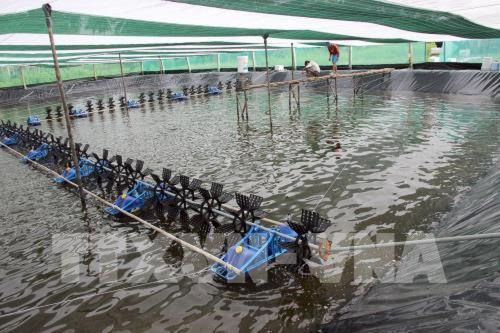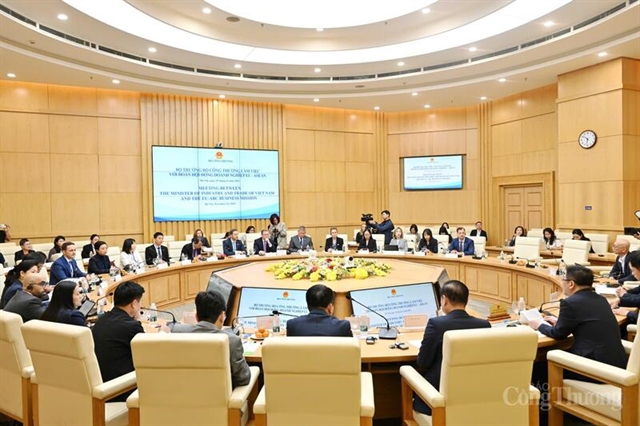 Society
Society

The Mekong Delta province of Cà Mau has developed models that apply advanced farming techniques and increase co-operation among stakeholders in production and consumption.
 |
| A shrimp pond that uses advanced farming techniques in Cà Mau Province. – VNA/VNS Photo Huỳnh Thế Anh |
CÀ MAU — The Mekong Delta province of Cà Mau has developed models that apply advanced farming techniques and increase co-operation among stakeholders in production and consumption.
In recent years, the province’s agricultural production has adapted to market demand and increased value for agricultural products.
Last year, 22 shrimp processing companies signed 66 contracts to develop shrimp value chains with 15 co-operative teams and co-operatives. The teams and co-operatives have a total of 800 household members.
Under the co-operation, companies supply raw materials and farming techniques for the households to breed shrimp and buy their shrimp for processing.
The co-operation also helps the households develop certified shrimp farming areas.
Châu Công Bằng, deputy director of the province’s Department of Agriculture and Rural Development, said the co-operation was one of the province’s agriculture’s significant accomplishments last year.
The province has developed co-operation chains for other agricultural products such as clean, high-yield rice in Trần Văn Thời District, specialty rice and shrimp grown in rotation on rice fields in Thới Bình District, and vegetables in Cà Mau City’s Lý Văn Lâm Commune.
“Many co-operation chain models have been successful in recent years, helping to shift agriculture toward commercial production and exploiting the advantages of each locality,” Bằng said.
Cà Mau has about 85,000ha of rice, 7,000ha of vegetables and 5,400ha of banana. However, the production remains on a small scale and is scattered.
Cà Mau has zoned a 322ha hi-tech agriculture area in U Minh District’s Khánh Lâm Commune for vegetables and fruits, and rice seeds, to 2030.
The investment for the hi-tech agriculture area is VNĐ344 billion (US$14.8 million). The province’s authorities are calling on domestic and foreign sources to invest in the hi-tech agriculture area.
To help the area, the province will also use the State budget to build infrastructure such as roads, irrigation and waste treatment facilities.
Aquaculture
The province has 300,000ha of aquaculture, the country’s largest aquaculture area. Of the area, shrimp farming totals 280,000ha, equal to 40 per cent of the country’s total shrimp farming area.
Many shrimp farmers have participated in co-operatives and applied advanced farming techniques in breeding shrimp under Good Agricultural Practice (GAP) standards, including organic, VietGAP and Global GAP standards.
The Cái Bát Aquaculture Co-operative in Cái Nước District’s Hòa Mỹ Commune is one of the province’s exemplary co-operatives that uses advanced farming techniques for production. The co-operative breeds shrimp and crab and grows bulrush, an edible wet plant.
Nguyễn Văn Lâm, chairman of Cái Bát, said the co-operative’s 350ha of shrimp are farmed under Aquaculture Stewardship Council (ASC) and VietGAP standards.
The co-operative’s members breed shrimp under various models, including intensive and extensive farming.
About 4,000 farmers in Cà Mau are co-operating with companies to breed 20,000ha of organic shrimp that offers farmers 5 per cent more value than normal shrimp.
The province’s organic shrimp are exported to the US and EU.
The province targets having 279,000ha of brackish water shrimp with an annual output of 233,000 tonnes and 15,000ha of giant river prawns with an annual output of 4,500 tonnes next year.
The province is giving priority to shrimp farming areas under organic and good agricultural practices. It is also expanding certified shrimp farming models.
Lê Văn Sử, deputy chairman of the province’s People’s Committee, said the province would have support policies for companies to develop the model effectively.
The province will review areas zoned for farming shrimp to develop the model, he said.
The provincial People’s Committee has instructed relevant departments and agencies to seek geographical indication for Cà Mau black tiger shrimp.
Cà Mau targets having annual shrimp export value of $1.8 billion next year and $2.5 billion by 2025. — VNS




